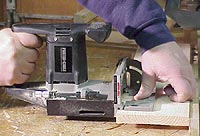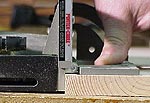This is a Veteran Owned site
Misaligned BiscuitsText and photos by Tom Hintz When I received a new Porter Cable biscuit joiner for Christmas, I thought my days of misaligned glued-up panels were over. They could have been, should have been, but they were not, yet anyway. Originally, I thought the mistake I was making was dumb enough that I should keep it to myself. Then, soon after I posted an article about my biscuit joiner in the tool section of this web site, I received a few emails from others with similar tools, having similar problems. This caused me to look harder at what was happening. It was then I stumbled on my mistake. Most of the wood I use the biscuit joiner on is ¾ inch solid stock. I realized that ALL of the stock I had this problem with was the ¾-inch-thick stock. Though I was dutifully preparing the edges on the jointer, my biscuited joints were coming out uneven vertically, sometimes by more than 1/16 inch. The biscuits were the proper size and fit the slots snug, but still, the joints would vary, apparently at random. The problem was not with the biscuit joiner itself, but resulted from a combination of varying wood thickness, setup and surface irregularities on my workbench. The housing surrounding the blade on the biscuit joiner is almost ¾ inch thick. With the fence lowered to the 90-degree position, this housing would be parallel to the workbench surface. When the stock being slotted was actually ¾-inch-thick, and nothing was trapped beneath the jointer, the slots were properly located and the joints came out smooth. If the wood was even slightly under ¾-inch-thick, or there was a dried spot of glue or a wood chip under it, the joiner would be held up, or at a slight angle to the workpiece. The slot would then be misplaced. The seam simply could not line up properly. How the joiner is set up also has an impact on the problem. The fence is adjustable up and down to allow centering of the biscuit slot in the wood. Here again, with ¾-inch-thick stock, the bottom of the housing can be very close to, or actually touching the table surface. I routinely set the depth of the housing on a small cutoff of the wood being used, and did this with the joiner on it's side. Interference with the table top was not obvious during this procedure. The result can be the same misalignment of the biscuit slots. The fix is frustratingly simple. Place the wood being joined on another piece so that it is high enough off the work surface to insure a comfortable gap between the joiners base and the work surface and all is well in biscuit joining land. The slots line up, the joints are even and my frustration level has subsided considerably. So far in my woodworking experience, the remedies for problems I have encountered have tended to be simple. As in this case, inexperience contributed to the problem, but common sense eventually came to the rescue and I recognized the solution. |
||
Do you have a comment about this page? - Email Me!
|
All written, photographic and drawn materials are property of and copyright by NewWoodworker.com LLC 2000-2019. Materials may not be used in any way without the written permission of the owner.



